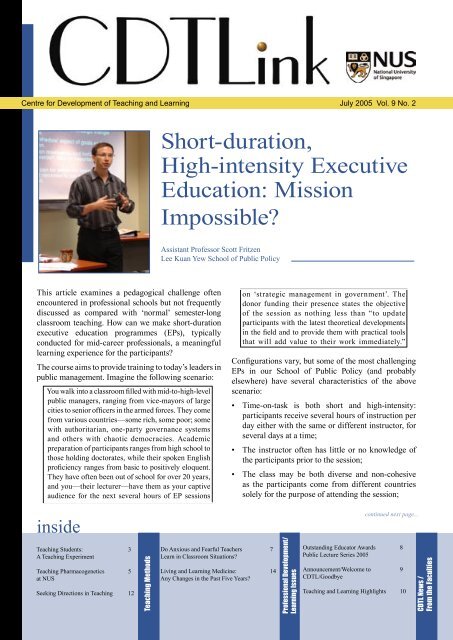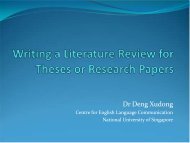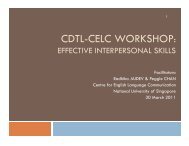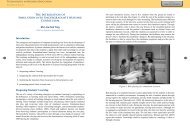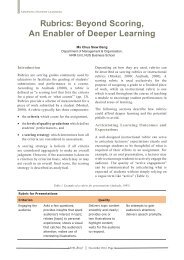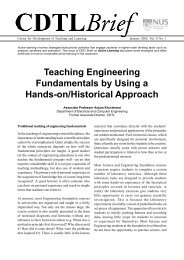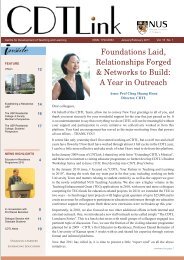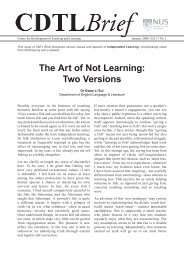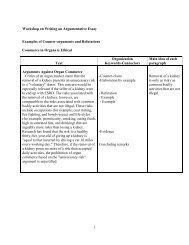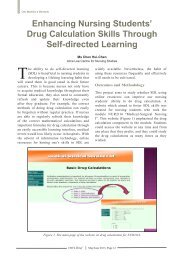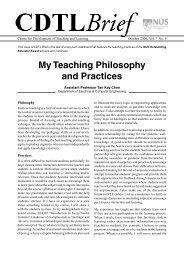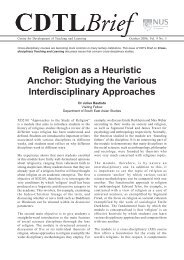July 2005 Vol. 9 No. 2 - CDTL - National University of Singapore
July 2005 Vol. 9 No. 2 - CDTL - National University of Singapore
July 2005 Vol. 9 No. 2 - CDTL - National University of Singapore
You also want an ePaper? Increase the reach of your titles
YUMPU automatically turns print PDFs into web optimized ePapers that Google loves.
Centre for Development <strong>of</strong> Teaching and Learning <strong>July</strong> <strong>2005</strong> <strong>Vol</strong>. 9 <strong>No</strong>. 2<br />
Short-duration,<br />
High-intensity Executive<br />
Education: Mission<br />
Impossible?<br />
Assistant Pr<strong>of</strong>essor Scott Fritzen<br />
Lee Kuan Yew School <strong>of</strong> Public Policy<br />
This article examines a pedagogical challenge <strong>of</strong>ten<br />
encountered in pr<strong>of</strong>essional schools but not frequently<br />
discussed as compared with ‘normal’ semester-long<br />
classroom teaching. How can we make short-duration<br />
executive education programmes (EPs), typically<br />
conducted for mid-career pr<strong>of</strong>essionals, a meaningful<br />
learning experience for the participants?<br />
The course aims to provide training to today’s leaders in<br />
public management. Imagine the following scenario:<br />
You walk into a classroom filled with mid-to-high-level<br />
public managers, ranging from vice-mayors <strong>of</strong> large<br />
cities to senior <strong>of</strong>ficers in the armed forces. They come<br />
from various countries—some rich, some poor; some<br />
with authoritarian, one-party governance systems<br />
and others with chaotic democracies. Academic<br />
preparation <strong>of</strong> participants ranges from high school to<br />
those holding doctorates, while their spoken English<br />
pr<strong>of</strong>iciency ranges from basic to positively eloquent.<br />
They have <strong>of</strong>ten been out <strong>of</strong> school for over 20 years,<br />
and you—their lecturer—have them as your captive<br />
audience for the next several hours <strong>of</strong> EP sessions<br />
on ‘strategic management in government’. The<br />
donor funding their presence states the objective<br />
<strong>of</strong> the session as nothing less than “to update<br />
participants with the latest theoretical developments<br />
in the field and to provide them with practical tools<br />
that will add value to their work immediately.”<br />
Configurations vary, but some <strong>of</strong> the most challenging<br />
EPs in our School <strong>of</strong> Public Policy (and probably<br />
elsewhere) have several characteristics <strong>of</strong> the above<br />
scenario:<br />
• Time-on-task is both short and high-intensity:<br />
participants receive several hours <strong>of</strong> instruction per<br />
day either with the same or different instructor, for<br />
several days at a time;<br />
• The instructor <strong>of</strong>ten has little or no knowledge <strong>of</strong><br />
the participants prior to the session;<br />
• The class may be both diverse and non-cohesive<br />
as the participants come from different countries<br />
solely for the purpose <strong>of</strong> attending the session;<br />
inside<br />
Teaching Students: 3<br />
A Teaching Experiment<br />
Teaching Pharmacogenetics 5<br />
at NUS<br />
Seeking Directions in Teaching 12<br />
Teaching Methods<br />
Do Anxious and Fearful Teachers 7<br />
Learn in Classroom Situations?<br />
Living and Learning Medicine: 14<br />
Any Changes in the Past Five Years?<br />
Pr<strong>of</strong>essional Development/<br />
Learning Issues<br />
continued next page...<br />
Outstanding Educator Awards 8<br />
Public Lecture Series <strong>2005</strong><br />
Announcement/Welcome to 9<br />
<strong>CDTL</strong>/Goodbye<br />
Teaching and Learning Highlights 10<br />
<strong>CDTL</strong> News /<br />
From the Faculties
2<br />
PROFESSIONAL DEVELOPMENT<br />
• The ‘stakes’ <strong>of</strong> the training for participants are<br />
limited since there is generally no assessment and<br />
since third parties (e.g. governments or donors) are<br />
<strong>of</strong>ten paying for the training;<br />
A daunting teaching assignment, or is it mission<br />
impossible? The answer depends, <strong>of</strong> course, on one’s<br />
ambitions. It is not particularly difficult to keep the<br />
class occupied for the time required; indeed, this<br />
requires little more than an adaptation <strong>of</strong> teaching<br />
materials typically used in one’s semester-long courses.<br />
But what could make this format actually useful for<br />
participants?<br />
Some lessons learned<br />
The following five guidelines have grown out <strong>of</strong> my<br />
active experimentation in EPs over the past five years:<br />
1. Keep it simple. This piece <strong>of</strong> advice, true enough in<br />
our normal classes, is even more relevant for EPs.<br />
The temptation to take the ambitious and externally<br />
imposed learning objectives (such as those listed in<br />
the scenario above) too literally can and will lead<br />
to information overload and an easily forgotten<br />
session. This leads to the next point, which may be<br />
more controversial.<br />
2. Leverage learning by encouraging small shifts in<br />
perspective rather than formal content. Einstein<br />
once said that “imagination is more important<br />
than knowledge.” Whether or not this applies<br />
to a semester-long calculus course, I take it is as<br />
my <strong>No</strong>rth Star when designing EP sessions. I<br />
know the EP sessions I facilitate have worked as<br />
intended when they leave participants with an<br />
unexpected insight—one that helps them to see a<br />
complexity behind an otherwise familiar aspect <strong>of</strong><br />
their work. To accomplish this, I look for relatively<br />
simple but intuitive frameworks that essentially<br />
invite participants to organise their own extensive<br />
pr<strong>of</strong>essional experience in new ways. My aim is<br />
for such heuristics to be remembered and to prove<br />
useful even several months after the session. But<br />
this requires going beyond a lecture presentation<br />
<strong>of</strong> a particular framework, which brings us to point<br />
three.<br />
3. Build the session around interactive problemsolving.<br />
One benefit <strong>of</strong> an ‘imagination’-driven<br />
approach to EP teaching is that it allows more<br />
time for what may really wake participants up—<br />
interactive problem-solving. For my sessions, this<br />
typically takes the form <strong>of</strong> joint analysis <strong>of</strong> case<br />
studies. Participants are presented with an openended<br />
policy or managerial dilemma and asked to<br />
develop and present their own recommendations for<br />
its resolution using one <strong>of</strong> the frameworks taught in<br />
the session. I find that by mixing challenging and<br />
easy questions, I can reach almost all participants at<br />
some point during the session.<br />
4. Raise the stakes. As noted above, the lack <strong>of</strong> any<br />
form <strong>of</strong> participant assessment, coupled with the<br />
fatigue factor caused by an <strong>of</strong>ten gruelling EP<br />
schedule, means that participant motivation and<br />
energy can <strong>of</strong>ten wane. The interactive, problemsolving<br />
approach may help combat fatigue, as do<br />
small-group work, presentations <strong>of</strong> case analysis and<br />
organised debates between teams <strong>of</strong> participants.<br />
Such activities turn up the heat in the classroom.<br />
As successful pr<strong>of</strong>essionals, participants are <strong>of</strong>ten<br />
eager to demonstrate their creative problem-solving<br />
skills to their peers du jour (and at least not appear<br />
unprepared).<br />
Incentives matter for the instructor as well.<br />
Participant evaluation forms are common (but still<br />
not universal) practice. But since the evaluation<br />
results are typically not linked to any obvious<br />
consequences, they can <strong>of</strong>ten fail to motivate<br />
instructors to make an extra effort in these ‘one<strong>of</strong>f’<br />
courses. One well-known principle is to make<br />
participant feedback on all EP sessions available<br />
to all instructors involved. Having joint planning<br />
and debriefing sessions among faculty members<br />
and EP clients can also help create an enabling<br />
environment for continuous improvement and<br />
sustained instructor effort. These steps additionally<br />
help promote the customisation and coordination <strong>of</strong><br />
content that are essential for high-impact EPs.<br />
5. Innovate! The Executive Programme practice is<br />
constantly evolving. We are only now beginning to<br />
incorporate distance and e-learning tools into EPs.<br />
Such tools may help overcome some constraints<br />
inherent in the EP format (for instance, enabling even<br />
short programmes to include assessed participant<br />
work).<br />
Whatever the form EPs take in the future, the core<br />
principles <strong>of</strong> focus, interactivity, attention to learner<br />
and instructor motivation, as well as continuous<br />
innovation are likely to be just as important as they are<br />
today.<br />
<strong>CDTL</strong>ink <strong>July</strong> <strong>2005</strong>
TEACHING METHODS<br />
3<br />
Teaching Students:<br />
A Teaching Experiment<br />
Associate Pr<strong>of</strong>essor Joel Lee<br />
Faculty <strong>of</strong> Law<br />
In this paper, I will document a teaching experiment<br />
conducted for first year law students taking LC1004,<br />
“Law <strong>of</strong> Torts” in AY 2002/2003, examine students’<br />
feedback on the experiment and propose some<br />
guidelines for the further exploration <strong>of</strong> the method.<br />
The experiment<br />
Ideally, a tutorial should be a lively discussion for<br />
students to apply what they have learnt and raise<br />
questions. However, in reality, this is rarely the case<br />
for various reasons and tutorials <strong>of</strong>ten became minilectures.<br />
The main idea for my experiment was to teach<br />
students by having them teach because I believe that a<br />
person learns most when he/she has to teach. Getting<br />
students to teach other students meant that they must<br />
not only understand the content, but also think through<br />
how it fits together. Furthermore, this role reversal puts<br />
students in the teacher’s shoes. Students now have to<br />
think not only about content and structure, but also<br />
how best to convey the information effectively. My<br />
aspiration was that students would realise that a pure<br />
lecture method was not necessarily the best way to teach<br />
and learn. Finally, it was hoped that with this method,<br />
students will gain confidence in public speaking.<br />
This experiment was conducted over two tutorial<br />
sessions (Sessions 1 and 2) with students divided into<br />
two teams (Teams A and B) two weeks before the first<br />
session began. In Session 1, Team A would conduct<br />
the tutorial as if they were the teachers and Team B<br />
the students. Students from both teams were told that<br />
they would have complete freedom to structure and<br />
conduct the tutorial. They could consult me as many<br />
times as they wished two weeks before their respective<br />
sessions began, after which I would only sit in as if I<br />
were a student. As students during Session 1, Team B<br />
was expected to be prepared for and to contribute to the<br />
discussion at hand. Students were also informed that<br />
their performance though noted, would not be graded.<br />
The sessions<br />
In all the sessions I attended, both teams came prepared<br />
to present and participate. While there was some initial<br />
hesitation on the part <strong>of</strong> the teaching team, once they<br />
realised that I was not going to formally start the class,<br />
they took matters into their own hands and began the<br />
class. Interestingly, the teaching teams all opted to teach<br />
by facilitating responses from the class. <strong>No</strong>ne adopted<br />
the ‘mini-lecture’ approach with which they were<br />
familiar. However, a number <strong>of</strong> problems did surface<br />
through the course <strong>of</strong> the sessions. These include:<br />
1. Occasional foray into irrelevancies. A student<br />
would bring up a point which was irrelevant to the<br />
discussion and the teaching team either did not have<br />
the experience to recognise that the discussion was<br />
going <strong>of</strong>f tangent or did not have the abilities to draw<br />
the discussion back. In this situation, I had to ask (in<br />
the role <strong>of</strong> a student) how the point raised fit in with<br />
the current discussion. This was usually sufficient to<br />
bring the discussion back on track.<br />
2. Occasional gap in content coverage. This was<br />
generally due to the teaching team not realising<br />
or overlooking a vital point. This did not come<br />
as a surprise to me and a simple question that<br />
addressed the missing point will solve the problem.<br />
Interestingly, when brought up in this manner,<br />
the teams were able to address the missing point<br />
correctly.<br />
3. Uncertainty <strong>of</strong> the state <strong>of</strong> the law. This was not<br />
surprising considering that the tutorial sheet was<br />
designed to highlight the ambiguous areas in the<br />
law. This uncertainty was typically handled in<br />
two ways. The first was resolving the uncertainty<br />
through the process <strong>of</strong> class discussion. This was<br />
ideal as students then weighed the opposing views<br />
and came to their reasoned conclusions. The second<br />
way was for students to accept that this particular<br />
area <strong>of</strong> law was uncertain and be able to argue both<br />
for and against. In some cases, students were able<br />
to traverse this difficulty on their own. In others, I<br />
would intervene by asking appropriate questions.<br />
Interestingly, none <strong>of</strong> the presenting teams got the law<br />
wrong. This reinforced my belief that students can learn<br />
the law on their own provided that there are sufficient<br />
guidelines and parameters to assist them. At the end<br />
<strong>of</strong> each session, both teams were asked to provide<br />
feedback on the experiment via email.<br />
Feedback<br />
Generally, students’ feedback on the experiment was<br />
positive. Four main themes emerged from the feedback:<br />
continued next page...<br />
<strong>July</strong> <strong>2005</strong> <strong>CDTL</strong>ink
4<br />
TEACHING METHODS<br />
1. Ownership <strong>of</strong> the lesson. Students felt that this<br />
method gave them more ownership <strong>of</strong> the lesson<br />
which motivated them to prepare for class, respond<br />
to the teaching team’s questions and engage in<br />
discussions.<br />
2. Effect on learning. From the feedback, it appeared<br />
that this method had a significant effect on students’<br />
learning. By requiring them to prepare and teach,<br />
students were compelled to fully understand the<br />
content <strong>of</strong> that session. As one student wrote:<br />
[It made me] aware <strong>of</strong> the fact that I<br />
had to be a lot more organised. […It’s]<br />
different when you conduct a class<br />
because you have to be a lot more<br />
certain about the different issues and<br />
the different strands <strong>of</strong> arguments<br />
and to make sure they follow the<br />
same thread and to make sure they<br />
eventually end up somewhere.<br />
In addition, requiring the presenting teams to<br />
respond to questions from the other students allowed<br />
them to work through their own areas <strong>of</strong> doubt and<br />
uncertainty as they formulated responses to those<br />
questions.<br />
3. The learning environment. Some students felt that<br />
having their peers conduct the class created a good<br />
environment for exploration and learning. Because<br />
students knew each other well, their intra-group<br />
rapport created a fun and relaxed atmosphere<br />
which relieved some tension for the teaching team.<br />
One student expressed:<br />
I felt less inhibited in asking questions<br />
and challenging the answers presented<br />
by other students (Perhaps this is<br />
reflective <strong>of</strong> the respect Asian students<br />
generally have for their teachers,<br />
which may in certain circumstances<br />
inhibit students from putting forward<br />
any question or argument that may<br />
seem rude to the teacher).<br />
4. Student development. In the process <strong>of</strong> teaching<br />
and working together as a team, students developed<br />
effective presentation and learned to work as a<br />
team. This would be particularly useful to their<br />
future careers as lawyers.<br />
Of course, as with all things, there was feedback about<br />
difficulties faced by the students:<br />
1. Amount <strong>of</strong> time and effort needed. A common<br />
difficulty was that some students felt that the time<br />
and effort needed for them to do this well placed<br />
burden on an existing heavy workload. Another<br />
student felt that:<br />
[B]ecause we don’t know very much<br />
about what we don’t know, […] I think<br />
a disproportionate amount <strong>of</strong> time is<br />
committed towards investigating the<br />
subject.<br />
In fairness, there is some truth to this. This<br />
experiment basically threw students into the deep<br />
end. Further, because this was a new activity for<br />
the students, their unfamiliarity with the subject<br />
would lead to some stress and take more time this<br />
first time round.<br />
2. Uncertainty in learning. Students were uncertain<br />
whether they were learning the correct things. There<br />
are two aspects to this. Firstly, they were not confident<br />
that they were on the right track. The ambiguity <strong>of</strong><br />
the law and the lack <strong>of</strong> a teacher-imposed structure in<br />
the class contributed to this uncertainty. There were<br />
also concerns that students answering the questions<br />
<strong>of</strong> other students was a matter <strong>of</strong> “the blind leading<br />
the blind”. Secondly, because <strong>of</strong> students’ lack <strong>of</strong><br />
knowledge and experience, there was also a feeling<br />
that the class may not be getting as much as they<br />
should from the session.<br />
Again, these are admittedly fair concerns. As<br />
mentioned earlier, there were times where<br />
intervention was necessary to bring the discussion<br />
back on track or fill in a content gap. However,<br />
student feedback also revealed an ‘over-concern’<br />
with acquiring the correct content as opposed to<br />
focusing on the processes <strong>of</strong> thinking, reasoning<br />
and argumentation.<br />
3. Issues relating to teamwork. There were three main<br />
concerns relating to working as a team. The first<br />
was that the working groups<strong>of</strong> about 6–8 students<br />
might have been too large. On hindsight, teams<br />
<strong>of</strong> 2–4 students might have been more ideal. This<br />
leads to the second concern that there was unfair<br />
distribution <strong>of</strong> work in some cases. Requiring<br />
students to submit a written or verbal report before<br />
the class and allocating marks for their performance<br />
might have helped to resolve this issue.<br />
The final concern relating to teamwork was that <strong>of</strong><br />
overspecialisation. As one student expressed it:<br />
Students are delegated various areas/<br />
questions to do, which if done well<br />
means that they are very well versed<br />
in that area. The flip side is that if the<br />
question is not broad enough, they are<br />
ONLY well versed in that area… as<br />
compared to usually when they have<br />
to do all the questions.<br />
This is a fair concern and presumably, relevant only<br />
from the viewpoint <strong>of</strong> the teaching team. Again,<br />
this can in part be addressed by having smaller<br />
working groups and careful drafting <strong>of</strong> the tutorial<br />
questions to encompass a balanced coverage <strong>of</strong><br />
issues.<br />
continued on page 13...<br />
<strong>CDTL</strong>ink <strong>July</strong> <strong>2005</strong>
TEACHING METHODS<br />
5<br />
Teaching Pharmacogenetics at<br />
NUS<br />
Assistant Pr<strong>of</strong>essor Zhou Shufeng<br />
Department <strong>of</strong> Pharmacy<br />
Introduction<br />
Pharmacy is a healthcare pr<strong>of</strong>ession that deals with<br />
all aspects <strong>of</strong> medicines, including the manufacture,<br />
supply and management <strong>of</strong> drug therapy for patients.<br />
The primary aim <strong>of</strong> the pharmacy course at the <strong>National</strong><br />
<strong>University</strong> <strong>of</strong> <strong>Singapore</strong> (NUS) is to provide students<br />
with relevant knowledge and skills required for entry<br />
into the pr<strong>of</strong>ession. The course focuses on laying a strong<br />
foundation in topics related to pharmaceutical sciences<br />
and pharmacy practice so that graduates can readily<br />
apply these fundamental and important principles to<br />
their future practice, be it in the community, hospital,<br />
healthcare, pharmaceutical industry or research.<br />
Current concepts in drug therapy <strong>of</strong>ten attempt drug<br />
treatment <strong>of</strong> large patient populations as groups,<br />
irrespective <strong>of</strong> the potential for individual, genetically<br />
based differences in drug response (Evans & Relling,<br />
1999). It is well recognised that most medications<br />
exhibit wide inter-patient variability in their efficacy and<br />
toxicity. Pharmacogenetics, the study <strong>of</strong> how the genetic<br />
variations affect drug response in individual patients<br />
(Evans & McLeod, 2003), emphasises the identification<br />
<strong>of</strong> the network <strong>of</strong> genes that governs drug response<br />
in individual patients using genome-wide approaches<br />
(Evans & Johnson, 2001). All <strong>of</strong> these will lead to novel<br />
approaches in drug discovery, individualised medication<br />
dosage and new insights into disease susceptibility and<br />
prevention (Milos & Seymour, 2004). Pharmacogenetics<br />
and pharmacogenomics, both interchangeable, may<br />
help focus effective therapy on smaller patient subpopulations<br />
which, despite demonstrating the same<br />
disease phenotype, are characterised by distinct genetic<br />
pr<strong>of</strong>iles.<br />
Due to the importance <strong>of</strong> pharmacogenetics, the<br />
great potential application <strong>of</strong> pharmacogenetics in<br />
future medicine and the vital role <strong>of</strong> pharmacists in<br />
healthcare, pharmacy students must be educated with<br />
adequate knowledge in pharmacogenetics (Frueh<br />
& Gurwitz, 2004). In NUS, pharmacogenetics is<br />
incorporated into other modules (e.g. pharmacokinetics<br />
and toxicokinetics). In this paper, I will highlight<br />
my experience teaching pharamacogenetics at NUS,<br />
emphasising on teaching topics, approaches, evaluation,<br />
emerging problems and possible solutions.<br />
My teaching <strong>of</strong> pharmacogenetics for pharmacy<br />
students at NUS<br />
In AY 2004/<strong>2005</strong>, pharmacogenetics is incorporated into<br />
three modules, namely, PR3106 “Pharmacokinetics and<br />
Drug Disposition”, PR4207 “Applied Pharmacokinetics<br />
and Toxicokinetics” and PR5113 “Clinical<br />
Pharmacokinetics and Therapeutic Drug Monitoring”,<br />
to cater to students at both the undergraduate and<br />
postgraduate levels with a basic knowledge in human<br />
genetics and pharmacology.<br />
Te a c h i n g a p p r o a c h e s i n v o l v e d f o r<br />
pharmacogenetics<br />
The application and combination <strong>of</strong> the major teaching<br />
methods I use may vary depending on the module and<br />
students (Table 1). An IVLE website is also set up for<br />
each module and a forum is used for discussion on<br />
pharmacogenetic topics. The lecturer will monitor the<br />
forum and provide proper guidance regularly.<br />
Table 1. Major teaching methods for pharmacogenetics.<br />
Module<br />
number<br />
PR3106<br />
PR4207<br />
PR5113<br />
Teaching methods for<br />
pharmacogenetics<br />
Lecturing, tutorial, individual<br />
projects, case study, IVLE, continuous<br />
assessment<br />
Lecturing, tutorial, group projects,<br />
student presentation for case study,<br />
IVLE, continuous assessment<br />
Lecturing, tutorial, individual projects,<br />
student presentation for case study,<br />
IVLE, continuous assessment<br />
In addition, I have also provided a number <strong>of</strong> useful<br />
websites, journals and books to students. Many key<br />
points in my lecture notes are extracted from these<br />
materials and students are encouraged to read them<br />
thoroughly if time allows.<br />
continued next page...<br />
<strong>July</strong> <strong>2005</strong> <strong>CDTL</strong>ink
6<br />
TEACHING METHODS<br />
Problems and possible solutions in my teaching<br />
<strong>of</strong> pharmacogenetics<br />
Efficiency <strong>of</strong> my teaching methods<br />
Choosing the proper teaching methods for a complex<br />
subject like pharmacogenetics is important. Student<br />
feedback indicate that the methods I used (Table 1) are<br />
basically and technically efficient, although there are<br />
some concerns (Table 2).<br />
Table 2. Major teaching methods for pharmacogenetics.<br />
Major concerns<br />
from students<br />
There is too much to<br />
memorise<br />
Some concepts are hard to<br />
understand<br />
There are too many drugs as<br />
examples<br />
Individual project is timeconsuming<br />
Case study is timeconsuming<br />
Some diseases as examples<br />
are too simple<br />
Tutorial is too short<br />
IVLE forum is not active<br />
Possible<br />
solutions<br />
Less topics, less lecture<br />
notes<br />
More elaboration and<br />
details<br />
Less drug as examples<br />
Set up group project<br />
Less case study and<br />
converted to group project<br />
More elaboration and<br />
details<br />
Increase tutorial time<br />
Encourage active<br />
participation<br />
There is debate about what the various complexities<br />
and implications <strong>of</strong> teaching pharmacogenetics are.<br />
On the one hand, pharmacogenetics contains multiple<br />
fundamental scientific concepts that are really complex,<br />
but its education for pharmacists must focus on the<br />
application <strong>of</strong> such complex science in clinical settings.<br />
On the other hand, gaining key pharmacogenetic<br />
knowledge in pharmacists will benefit patients to some<br />
extent by turning this knowledge into practice and<br />
eventually the well-being <strong>of</strong> patients.<br />
There is a growing expansion <strong>of</strong> pharmacogenetic<br />
knowledge with the advent <strong>of</strong> Human Genome Project.<br />
Thus, there is a need to incorporate this increasingly complex<br />
body <strong>of</strong> knowledge to the standard curriculum <strong>of</strong> pharmacy<br />
schools. Some additional topics in pharmacogenetics are<br />
<strong>of</strong> importance, but, due to time constraints, not included<br />
in my classes. These important topics should be included<br />
if a new module on pharmacogenetics is launched for<br />
pharmacy students at NUS.<br />
However, there is still considerable space for me to<br />
improve and a flexible attitude and mindset are needed<br />
to better my teaching. I will also need to consider how<br />
my classes need to be dovetailed with other relevant<br />
topics such as pharmacotherapy and toxicology.<br />
Problems facing the teaching <strong>of</strong> pharmacogenetics in<br />
the faculty<br />
In pharmacy education, pharmacogenetics may<br />
receive less attention due to several reasons (Sansgiry,<br />
2004) including a) genetics and relevant disciplines<br />
are not considered as a priority for pharmacists; b)<br />
pharmacogenetics is a complex and large teaching area<br />
with uncertain coverage and teaching outcomes; c)<br />
long timescales will be required for both teachers and<br />
students; d) students may lack interest in this subject;<br />
e) there is already overcrowding <strong>of</strong> the curriculum;<br />
and f) shortage <strong>of</strong> adequately-trained teaching faculty.<br />
The last issue may be resolved when faculty members<br />
integrate pharmacogenetics into other courses, provided<br />
that they understand the relationship and relevance <strong>of</strong><br />
pharmacogenetics to the subject in question.<br />
Pharmacogenetics is becoming a core subject in<br />
some countries (Brock, Faulkner, Williams & Smith,<br />
2002) where pharmacists who play a key role in drug<br />
therapy and patient care (Sansgiry, 2004) are greatly<br />
valued. I suggest that an independent module on<br />
pharmacogenetics for pharmacy students be set up in<br />
the near future to help students construct comprehensive<br />
knowledge needed to achieve safe and optimal drug<br />
therapy in their future careers. For working pharmacists<br />
in <strong>Singapore</strong> and other East-South Asian countries,<br />
a continuing education or a special programme in<br />
pharmacogenetics may be set up to assist them in<br />
updating their pharmacogenetic knowledge.<br />
References<br />
Brock, T.P., Faulkner, C.M., Williams, D.M. & Smith, S.R. (2002).<br />
‘Continuing-education Programs in Pharmacogenomics for<br />
Pharmacists’, Am J Health Sys Pharm. <strong>Vol</strong>. 59, pp. 722–5.<br />
Evans, W.E. & Johnson, J.A. (2001). ‘Pharmacogenomics: the<br />
Inherited Basis for Interindividual Differences in Drug<br />
Response’, Annu Rev Genom Human Genet. <strong>Vol</strong>. 2, pp. 9–39.<br />
Evans, W.E. & McLeod, H.L. (2003). ‘Pharmacogenomics—Drug<br />
Disposition, Drug Targets, and Side Effects’, N Engl J Med.<br />
<strong>Vol</strong>. 348, pp. 538–549.<br />
Evans, W.E. & Relling, M.V. (1999). ‘Pharmacogenomics:<br />
Translating Functional Genomics into Rational Therapeutics’,<br />
Science. <strong>Vol</strong>. 286, <strong>No</strong>. 5439, pp. 487–491.<br />
Frueh, F.W. & Gurwitz, D. (2004). ‘From Pharmacogenetics to<br />
Personalized Medicine: a Vital Need for Educating Health<br />
Pr<strong>of</strong>essionals and the Community’, Pharmacogenomics. <strong>Vol</strong>.<br />
5, pp. 571–9.<br />
Milos, P.M. & Seymour, A.B. (2004). ‘Emerging Strategies and<br />
Applications <strong>of</strong> Pharmacogenomics’, Hum Genomics. <strong>Vol</strong>. 1,<br />
pp. 444–55.<br />
Sansgiry, S.S. (2004). ‘The Future <strong>of</strong> Pharmacy Education: Back to<br />
Which Basics?’ Pharmacotherapy. <strong>Vol</strong>. 4, pp. 688–9; 691–3.<br />
<strong>CDTL</strong>ink <strong>July</strong> <strong>2005</strong>
PROFESSIONAL DEVELOPMENT<br />
7<br />
Do Anxious and Fearful Teachers Learn<br />
in Classroom Situations?<br />
Senior Lecturer (Teaching) Lily Chong<br />
Human Resource Management Unit<br />
We <strong>of</strong>ten think emotions can affect our efficiency in the<br />
workplace. However, because they are such an intrinsic<br />
part <strong>of</strong> who we are and how we react to any situation,<br />
there is a need to understand, monitor and manage<br />
emotions effectively. In this paper, I will examine two<br />
particular emotions faced by most <strong>of</strong> us—anxiety and<br />
fear. Although anxiety and fear <strong>of</strong>ten go hand in hand,<br />
they are in fact very different emotions, as shown in<br />
Table 1 below.<br />
Table 1. Comparison between anxiety and fear.<br />
Anxiety<br />
Vague, indirect, selfdirected,<br />
performancerelated<br />
Formed, influenced<br />
and embedded in social<br />
relationships among<br />
colleagues and between<br />
teachers and students<br />
Fear<br />
Specific, conscious, direct,<br />
oriented towards an object<br />
or event<br />
Apprehension and tension<br />
arise from the anticipation<br />
<strong>of</strong> danger or threats to<br />
physical well-being<br />
In a single event, a person’s emotion may turn from fear<br />
to anxiety if it is perceived that there is no possibility <strong>of</strong><br />
escaping from or avoiding a dreaded situation or person.<br />
In the context <strong>of</strong> teaching and learning, teachers may<br />
experience a mixture <strong>of</strong> fear and anxiety, characterised by<br />
distress and uneasiness when we are faced with certain<br />
situations such as teaching evaluations. In particular, if<br />
the outcome <strong>of</strong> the evaluations can either make or break<br />
a teacher’s career, the possibility <strong>of</strong> failure constitutes<br />
a significant factor in the development <strong>of</strong> anxiety.<br />
Interestingly, studies 1 have observed that learning is<br />
unlikely to take place without anxiety. For instance, if the<br />
anxiety a teacher feels can be contained and managed<br />
effectively, it may generate an added motivation the<br />
teacher needs in order to succeed. However, anxiety<br />
may also undermine the positive outcome if the<br />
teacher lowers his/her expectations <strong>of</strong>, resists, avoids<br />
or abandons the learning experience because they are<br />
unable to manage the uncertainty or fear taking risks.<br />
This will undoubtedly hamper the potential for learning<br />
and positive change.<br />
Anxiety, therefore, has a strategic dimension in either<br />
supporting or inhibiting learning and change. Emotions,<br />
such as fear and anxiety, that underpin the experience <strong>of</strong><br />
teaching and learning, create both the possibilities for<br />
making the most <strong>of</strong> these strategic classroom moments<br />
and the capacity for ignoring them. Thus, teachers<br />
face unique learning situations created from emotional<br />
responses to experiences in the classroom setting.<br />
The emotional aspect <strong>of</strong> learning can <strong>of</strong>ten be difficult<br />
for teachers to acknowledge and work with. Learning is<br />
possible if a particular strategy <strong>of</strong> ensuring success (e.g.<br />
an appropriate choice <strong>of</strong> activities, pace <strong>of</strong> instruction<br />
or level <strong>of</strong> task difficulties) is employed during<br />
classroom instruction. Additionally, teachers can learn<br />
to accept mistakes, receive constructive feedback<br />
from colleagues and students alike. This provides<br />
them with the opportunities for learning: formulating<br />
expectancies, examining reasons for success and<br />
failure, or sharing concerns regarding future teaching<br />
evaluations. Furthermore, teachers can gain useful<br />
insights when denials, defensiveness and avoidance<br />
strategies are utilised as knowledge for learning.<br />
In conclusion, the extent to which teachers and<br />
organisations address these emotions and learning<br />
behaviours can make a difference to learning. In an<br />
environment where these emotions are acknowledged<br />
and dealt with positively, in-depth understanding and<br />
the development <strong>of</strong> learning and positive change are<br />
then possible.<br />
1. The following works support the claim that learning is not<br />
likely without anxiety:<br />
Vince, R. & Martin, L. (1993). ‘Inside Action Learning: the<br />
Politics and the Psychology <strong>of</strong> the Action Learning Model’,<br />
Management Education and Development. <strong>Vol</strong>. 24, <strong>No</strong>. 3, pp.<br />
205–215.<br />
K<strong>of</strong>man, F. & Senge, P.M. (1993). ‘Communities <strong>of</strong><br />
Commitment: the Heart <strong>of</strong> Learning Organizations’,<br />
Organizational Dynamics. <strong>Vol</strong>. 22, <strong>No</strong>. 2, pp. 5–23.<br />
Schein, E.H. (1993) ‘On Dialogue, Culture, and Organizational<br />
Learning’, Organizational Dynamics, <strong>Vol</strong>. 22, <strong>No</strong>. 2, pp. 40–<br />
51.<br />
<strong>July</strong> <strong>2005</strong> <strong>CDTL</strong>ink
8<br />
<strong>CDTL</strong> NEWS<br />
Outstanding Educator Award<br />
Public Lecture Series 5 May <strong>2005</strong><br />
Associate Pr<strong>of</strong>essor Kulwant Singh (Department<br />
<strong>of</strong> Business Policy) and Pr<strong>of</strong>essor Ip Yuen Kwong<br />
(Department <strong>of</strong> Biological Sciences), winners <strong>of</strong> the<br />
Outstanding Educator Award <strong>2005</strong>, delivered lectures<br />
as part <strong>of</strong> the OEA Public Lecture Series at the<br />
Engineering Auditorium on Thursday, 5 May <strong>2005</strong>.<br />
The Guest-<strong>of</strong>-Honour, Provost Tan Chorh Chuan,<br />
also issued certificates to the winners <strong>of</strong> the Excellent<br />
Teacher Award. Congratulations to all!<br />
Registration for the event<br />
Winners <strong>of</strong> the Outstanding Educator Award <strong>2005</strong>, A/Pr<strong>of</strong> Singh and Pr<strong>of</strong> Ip<br />
<strong>CDTL</strong> Director A/Pr<strong>of</strong> Pan giving the welcome address<br />
Tea-break discussion<br />
A/Pr<strong>of</strong> Singh giving his lecture<br />
Guest-<strong>of</strong>-Honour Provost Tan Chorh Chuan<br />
<strong>CDTL</strong>ink <strong>July</strong> <strong>2005</strong>
<strong>CDTL</strong> NEWS<br />
9<br />
Pr<strong>of</strong> Ip and the Provost<br />
Provost Tan and Excellent Teacher Award winner A/Pr<strong>of</strong> Cecilia Lim<br />
A/Pr<strong>of</strong> Pan inviting everyone to a scrumptious tea spread<br />
Provost Tan and Dr Chng Huang Hoon during the tea break<br />
Provost Tan engaged in discussion with the winners <strong>of</strong> Excellent Teacher Award<br />
Calling All Writers<br />
<strong>CDTL</strong> invites articles on any teaching<br />
and learning topic for the following two<br />
newsletters:<br />
• <strong>CDTL</strong>ink (700 words maximum per article;<br />
photos & illustrations in hard/digital copy<br />
are welcomed)<br />
• <strong>CDTL</strong>Brief (text-only newsletter; 1000 words<br />
maximum per article)<br />
To submit articles for consideration or to obtain<br />
more information, please contact:<br />
Sharon Koh<br />
Email: cdtsksp@nus.edu.sg<br />
Tel: (65)-6874 4692 • Fax: (65)-6777 0342<br />
Welcome!<br />
<strong>CDTL</strong> would like to welcome as Educational<br />
Technologist:<br />
Alena Yap Lee Yong, who joined us in January <strong>2005</strong>.<br />
Goodbye!<br />
We would also like to thank:<br />
Miss Lisa-Angelique Lim, our Research Assistant,<br />
who left in May <strong>2005</strong> for all her invaluable support<br />
in the past and wish her the best for her future<br />
endeavours.<br />
<strong>July</strong> <strong>2005</strong> <strong>CDTL</strong>ink
10<br />
FROM THE FACULTIES<br />
Teaching & Learning<br />
HIGHLIGHTS<br />
Yong Loo Lin School <strong>of</strong> Medicine<br />
Faculty Training Workshop <strong>2005</strong><br />
The Yong Loo Lin School <strong>of</strong> Medicine recognises that faculty<br />
training is imperative to implementing an assessment system that is<br />
beneficial to both students and teachers alike. The latest component<br />
in faculty training is the Key Features (KF) Test, a new assessment<br />
format based on clinical scenarios. It comprises a description <strong>of</strong> a<br />
problem followed by two or three questions focusing only on critical,<br />
challenging actions or decisions. KF is believed to assess a person’s<br />
essential clinical decision-making skills more accurately.<br />
The Medical Education Unit <strong>of</strong> the School recently organised a twoday<br />
workshop ‘Developing Key Feature Cases and Examinations’<br />
Figure 1. FOM workshop participants.<br />
(March 7–8, <strong>2005</strong>). Pr<strong>of</strong>essor George Bordage (<strong>University</strong> <strong>of</strong> Illinois,<br />
Chicago) and Dr Zubair Amin facilitated the workshop for 20 enthusiastic faculty members. The workshop was<br />
highly rated for its usefulness, interactivity and practicality.<br />
This is one <strong>of</strong> the several ongoing faculty development workshops on assessment. Other workshops implemented<br />
recently include Multiple Choice Questions, Extended Matching Item, Objective Structured Clinical<br />
Examination, Standard Setting and Blue Printing.<br />
Faculty <strong>of</strong> Science<br />
The Art-and-craft <strong>of</strong> Research in SPS<br />
One <strong>of</strong> the key objectives <strong>of</strong> the Special Programme in Science (SPS) has been and is to nurture talents among<br />
aspiring scientists. Since its inception in 1996, the programme has strived to foster a culture that imbues creative<br />
and critical thinking among its participants. To facilitate this, peer learning and teaching form the basis on which<br />
many <strong>of</strong> the academic activities are run.<br />
Leveraging on a strong mentorship programme, participants are engaged in academic pursuits by senior students<br />
and faculty, from attending interdisciplinary seminars to undertaking advanced research projects. Being<br />
primarily a faculty programme, students undertake focused literature surveys on topics that straddle various<br />
disciplines in science. For instance, in the last semester, students examined the theme <strong>of</strong> ‘Symmetry’ from diverse<br />
perspectives. This then served to initiate them into the arena <strong>of</strong> scientific investigation where they design and<br />
conduct laboratory experiments on a topic within the theme. With its interdisciplinary flavour, the programme<br />
provides an avenue for students from several disciplines to work together and it also lays the foundation for further<br />
research activities.<br />
<strong>CDTL</strong>ink <strong>July</strong> <strong>2005</strong>
FROM THE FACULTIES<br />
11<br />
School <strong>of</strong> Business<br />
Classroom @ Au Jardin, Les Amis<br />
Au Jardin, one <strong>of</strong> <strong>Singapore</strong>’s finest French restaurants located in the heart<br />
<strong>of</strong> the Botanic Gardens, became the classroom for 58 undergraduates taking<br />
the course, GEK1030 “Service Work—Winning Hearts and Minds”, on<br />
March 25, <strong>2005</strong>. It was indeed a ‘good’ Friday as students soaked in the<br />
exquisite ambience <strong>of</strong> a fine French restaurant. The restaurant’s staff shared<br />
their personal experience and provided students with first-hand knowledge<br />
<strong>of</strong> what it takes to excel in the service industry. The fine dining experience<br />
also provided an opportunity for students to participate, observe, evaluate the<br />
whole experience and relate them to what has been learnt in class. Indeed, the<br />
IVLE discussion forum was full <strong>of</strong> diverse insights after the outing! Beyond<br />
learning and dining, what did students value most from the experience? Fond<br />
memories <strong>of</strong> friendship and bonding @ Au Jardin!<br />
Figure 1. Cheers!<br />
Figure 2. Bon Appetit!<br />
Faculty <strong>of</strong> Engineering<br />
Industrial Participation Enhances Students’ Learning Experience from the Design Project<br />
The capstone Design Project (DP) is carried out by about 300 final-year undergraduates in the B.Eng. (Chemical<br />
Engineering), B.Eng. (Environmental Engineering) and B.Tech. (Chemical Engineering) programmes in their final<br />
semester. They are divided into teams <strong>of</strong> 4–7 students, each designing a process plant with different specifications.<br />
The DP challenges students to solve an open-ended and realistic problem, to take initiative and to develop creative<br />
solutions. In addition to applying knowledge gained from previous modules, students also learn new techniques,<br />
learn how to work independently and in teams, as well as hone their communication skills. The DP thus includes<br />
several aspects <strong>of</strong> integrative problem-based learning—students get to appreciate the interplay between chemical<br />
engineering principles, performance trade<strong>of</strong>fs, safety issues, environmental impact, economic implications and<br />
so on. The academic staff act as facilitators <strong>of</strong> the project.<br />
The DP not only provides a wholesome and realistic educational experience to students but also enlists <strong>Singapore</strong>’s<br />
thriving chemical and pharmaceutical industry to train future engineers. Consequently, the DP is <strong>of</strong>ten tied to<br />
problems <strong>of</strong> local interest (e.g. students designed a plant to produce potable water from sea water and municipal<br />
wastewater in AY 2002–03). Industry practitioners have been contributing to the DP for many years and their<br />
involvement has increased significantly in the recent years. For example, Mr. Aspi G. Vania and his team from<br />
<strong>Singapore</strong> Refining Company helped us with a DP on a crude distillation unit during AY 1998–99. Dr Larry June<br />
and his team <strong>of</strong> engineers (all <strong>of</strong> whom are NUS alumni) from Seraya Chemicals Pte Ltd participated actively in<br />
the DP involving a styrene plant during AY 2003–04. For AY 2004–<strong>2005</strong>’s DP, we have enlisted the help <strong>of</strong> Mr<br />
Wong Chee Seng (NUS alumnus and currently Manager <strong>of</strong> the Technical Support Section) <strong>of</strong> Ethylene Glycols<br />
<strong>Singapore</strong> Pte. Ltd.<br />
The industry practitioners help us in defining the project scope and contribute by providing industrial data, giving<br />
technical talks to all students, being available for weekly meetings with team leaders, participating in the IVLE<br />
forum and so on. Indeed, the industry practitioners’ involvement, participation and support in the DP have enhanced<br />
and enriched the learning experience <strong>of</strong> both students and faculty as they tap on the expertise and knowledge <strong>of</strong><br />
practising engineers. We are hopeful <strong>of</strong> continued strong support from <strong>Singapore</strong>’s chemical, petrochemical,<br />
pharmaceutical and related companies for the DP and indeed, for our overall educational mission.<br />
<strong>July</strong> <strong>2005</strong> <strong>CDTL</strong>ink
12<br />
TEACHING METHODS<br />
Seeking Directions in Teaching<br />
Associate Pr<strong>of</strong>essor Rajendran, K.<br />
Department <strong>of</strong> Anatomy<br />
Why teach?<br />
Teaching and learning have been integral to the human<br />
community from time immemorial and everyone is<br />
potentially a teacher one way or the other. In spite <strong>of</strong><br />
the high regard for the pr<strong>of</strong>ession, the choice to become<br />
a teacher is <strong>of</strong>ten a personal one. For me, I was largely<br />
influenced by an exposure to inspirational and dedicated<br />
teachers, who in various ways became role models, and<br />
also by the recognition <strong>of</strong> teaching as a kind <strong>of</strong> activity<br />
with a strong sense <strong>of</strong> community and likely to bring a<br />
sense <strong>of</strong> fulfillment from positively influencing young<br />
minds. Seeing teaching as an avenue for one’s creativity<br />
is perhaps quite critical as that will help generate the<br />
necessary passion and energy.<br />
Becoming a teacher<br />
The earliest anxiety for a lecturer is that <strong>of</strong> taking on<br />
the title <strong>of</strong> a teacher before having achieved any level<br />
<strong>of</strong> competence, a feeling further reinforced the moment<br />
students come into the picture. The appointment<br />
therefore was to become the <strong>of</strong>ficial beginning <strong>of</strong> a<br />
search for directions in teaching, and in many ways<br />
it was the students who would become key players in<br />
providing guidance. Under their influence, a gradual<br />
process <strong>of</strong> evolution occurs over the years especially<br />
in the absence <strong>of</strong> formal programmes in teaching<br />
methodology in one’s chosen field.<br />
Coping with information<br />
The basic sciences in Medicine are factually intensive<br />
and the only advantage as a novice teacher then was<br />
to have been in the same pr<strong>of</strong>ession and therefore<br />
endowed with some working knowledge but <strong>of</strong>ten<br />
lacking the broader picture and most <strong>of</strong> the details. The<br />
early efforts at ‘competence’ were therefore primarily<br />
driven by the acute awareness <strong>of</strong> appearing factually<br />
deficient to students. Details therefore frequently took<br />
priority over a meaningful structuring <strong>of</strong> information.<br />
Structuring <strong>of</strong> learning material<br />
Exposure to students’ learning activities around<br />
lectures, practical classes and tutorials has a pr<strong>of</strong>ound<br />
influence on the next stage <strong>of</strong> development to move<br />
beyond information. Lectures are ‘safe’ activities for<br />
the beginner teacher, almost totally within one’s control<br />
and easily designed to appear exhaustive to avoid being<br />
assaulted with embarrassing questions. Comprehensive<br />
handouts that match the actual presentation will give<br />
students a perceived sense <strong>of</strong> security. It is also<br />
desirable that the allocated lecture time be filled<br />
completely so that questions (if indeed they could be<br />
generated) could be answered late (if ever).<br />
It is soon apparent (from the kind <strong>of</strong> questions students<br />
actually come up with) that lectures can provide the<br />
ideal platform to deliver important visual or functional<br />
concepts. This, as opposed to detailed information, will<br />
allow students to develop the kind <strong>of</strong> understanding<br />
that will facilitate reflection and encourage the pursuit<br />
<strong>of</strong> self-directed expansion <strong>of</strong> knowledge. Essentially,<br />
they provide the basic tools for navigating the ocean<br />
<strong>of</strong> knowledge without getting hopelessly lost. Aiming<br />
to be comprehensive in the delivery <strong>of</strong> information in<br />
a lecture is <strong>of</strong>ten a futile attempt to outdo the reference<br />
texts which develop the ‘big picture’ that students lack.<br />
This should be an integral part <strong>of</strong> a lecture even at the<br />
expense <strong>of</strong> seemingly important details. Students need<br />
a sound framework onto which they can add the details<br />
comfortably. The promise <strong>of</strong> the big picture is <strong>of</strong>ten<br />
what attracts students to a lecture.<br />
Practical classes provide great opportunities to get<br />
to know students as individuals and to understand<br />
unique difficulties faced by different individuals. A<br />
degree <strong>of</strong> teacher-student bonding is likely to facilitate<br />
interaction and better learning. The management <strong>of</strong><br />
practical classes in human biology should focus more<br />
on the right approach and emphasis as well as aspects <strong>of</strong><br />
application to stimulate interest in the subject matter. To<br />
be effective, the number <strong>of</strong> students per tutor therefore<br />
requires to be the bare minimum. For the teacher,<br />
these classes are <strong>of</strong>ten the setting for discovering one’s<br />
own shortcomings. Being humble will help towards<br />
continued personal development and fostering respect<br />
from students who are <strong>of</strong>ten sharp enough to know who<br />
is trying to ‘bluff’.<br />
When conducted in a small group setting, tutorials<br />
give students the opportunity to demonstrate a level <strong>of</strong><br />
understanding <strong>of</strong> the subject as well as its application.<br />
In addition, stragglers can <strong>of</strong>ten be identified and<br />
<strong>CDTL</strong>ink <strong>July</strong> <strong>2005</strong><br />
continued next page...
TEACHING METHODS<br />
13<br />
given the appropriate advice and encouragement. The<br />
opportunity for mentoring should never be overlooked.<br />
Small group teaching is the closest one can get to an<br />
apprenticeship where close attention can be paid to the<br />
development <strong>of</strong> individual students, and opportunities<br />
taken to impart values and attitudes that help develop<br />
pr<strong>of</strong>essionalism in students.<br />
A personal teaching style<br />
Being sensitive to the difficulties faced by students<br />
will help develop a personal teaching style. Tutorials<br />
and practical classes are ideal settings to determine the<br />
areas where students falter and pick up new directions<br />
in teaching methodology. Positive reinforcement from<br />
students on experimental methods is therefore an added<br />
impetus. However, any experimentation with unique<br />
methods has to be balanced by an awareness <strong>of</strong> the<br />
broader curriculum requirements and an understanding<br />
<strong>of</strong> students’ capabilities and limitations.<br />
Shar i ng and exchang i ng <strong>of</strong> teach i ng<br />
approaches<br />
It would be a shame if existing good teaching practices<br />
are overlooked in favour <strong>of</strong> a personal style. Of subtle<br />
benefit is the habit, among colleagues, <strong>of</strong> sitting in at<br />
one another’s classes and exchanging ideas. <strong>No</strong>t only is<br />
one able to pick up different styles (both good and bad)<br />
on teaching but the exposure to related fields (taught by<br />
others) helps one develop a better integration <strong>of</strong> topics<br />
and broaden one’s own big picture. There is also the<br />
added benefit <strong>of</strong> generating team spirit among teachers<br />
who <strong>of</strong>ten have to work together towards common goals<br />
such as curricular development.<br />
Technology<br />
The advent <strong>of</strong> IT <strong>of</strong>fers a whole new dimension to<br />
the learning environment. User-friendly technology<br />
provides an outlet to one’s creativity in generating<br />
interactive s<strong>of</strong>tware to facilitate the visualisation<br />
<strong>of</strong> complex structure/function so essential to the<br />
understanding <strong>of</strong> biological processes. The teaching/<br />
learning experience enjoys a new level <strong>of</strong> efficiency<br />
which literally frees up a lot <strong>of</strong> useful knowledge from<br />
being categorised as ‘information overload’. With<br />
the current enthusiasm for trimming contents in the<br />
interests <strong>of</strong> relevance and integration, IT should be<br />
positioned to restore relevant disciplines closer to a<br />
continued on page 16...<br />
Teaching Students: A Teaching Experiment<br />
...continued from page 4<br />
Direction for the future<br />
The purposes <strong>of</strong> the experiment as set out earlier in this<br />
paper were achieved in varying degrees. Of course,<br />
one experiment and limited feedback are insufficient<br />
to determine the usefulness <strong>of</strong> this method. More<br />
‘experimentation’ over a period <strong>of</strong> time and by a<br />
broader base <strong>of</strong> teachers will be required. Below are<br />
some suggested guidelines for colleagues who might<br />
be interested in conducting similar experiments:<br />
• Small teams <strong>of</strong> 2–3 will be appointed the previous<br />
session to prepare for and teach the upcoming<br />
session. This will be done on a rotational basis<br />
so that everyone in the class can expect to be<br />
assigned such a role.<br />
• The teaching teams will have two consultation<br />
sessions with the teacher before their teaching<br />
session to assist them in their task and to clarify<br />
any doubts they might have.<br />
• Each student in the teaching team is expected to<br />
contribute equally to the preparation and teaching<br />
<strong>of</strong> the coming session.<br />
• Assuming the course allows for this, the teaching<br />
teams will be allocated a team grade that will<br />
count towards their final grade for that course.<br />
• During the teaching session, the teacher will be<br />
present as a ‘student’ to assist if necessary.<br />
• Specific tutorial questions should be drafted<br />
carefully to cover a range <strong>of</strong> issues relating to the<br />
particular topic.<br />
• The first consultation session should be arranged<br />
and instructions, expectations as well as<br />
distribution <strong>of</strong> the workload set out.<br />
• The second consultation session—held about three<br />
days before the teaching session—should focus<br />
on the team’s proposed teaching plan, method and<br />
content. The teaching team can also discuss areas<br />
<strong>of</strong> uncertainty and clarify doubts with regards to<br />
content.<br />
• The teacher should attend the class and intervene<br />
only where necessary (e.g. to bring a discussion<br />
gone awry back on track, point to a gap in content<br />
or reasoning). After the teaching session, the<br />
teacher might choose to meet with the teaching<br />
team a final time to provide feedback on the<br />
teaching session.<br />
<strong>July</strong> <strong>2005</strong> <strong>CDTL</strong>ink
14<br />
LEARNING ISSUES<br />
Living and Learning Medicine: Any<br />
Changes in the<br />
Past Five Years?<br />
Pr<strong>of</strong>essor Vernon Oh<br />
Yong Loo Lin School <strong>of</strong> Medicine<br />
In my last contribution to <strong>CDTL</strong>’s publications five<br />
years ago (Oh, 2000), I made two points which I<br />
will revisit in the present paper. I would first like to<br />
re-examine the statement that: “the smarter scientists<br />
understood the limitations <strong>of</strong> both the empirical method<br />
and available technology. Karl Popper has shown that<br />
experiments can only disprove hypotheses; in proving<br />
concepts, an element <strong>of</strong> uncertainty remains forever.<br />
Instead <strong>of</strong> being paralysed by uncertainty, however,<br />
students can and should derive a zest for research from<br />
it”.<br />
From my observations <strong>of</strong> students in the School <strong>of</strong><br />
Medicine for over 25 years, I believe that many are<br />
still unable to adapt their school-derived attitudes<br />
towards knowledge, and consequently fail—to an<br />
extent—to accept learning and research as an endless<br />
exploration, or an evolving adventure. Instead, they<br />
become increasingly discouraged by the lack <strong>of</strong><br />
certitude in many areas <strong>of</strong> medical science and, worse,<br />
the continuously evolving methods <strong>of</strong> diagnosis,<br />
investigation and <strong>of</strong> patient treatment. It is similarly<br />
unsettling for practising physicians to note <strong>of</strong>ten that<br />
the ‘best treatment’ <strong>of</strong> today becomes the obsolete or<br />
even harmful ‘misguided practice’ <strong>of</strong> yesterday.<br />
Faced with the shifting ground <strong>of</strong> medical knowledge, a<br />
few unfortunate students may be so fatigued or, worse,<br />
bored by the business <strong>of</strong> learning that they retreat to their<br />
default mode. By this, I mean the minimalist method<br />
<strong>of</strong> only learning just enough, and just in time, to pass<br />
the continuous assessments. In Medicine, this <strong>of</strong>ten<br />
means learning only the transient practice guidelines<br />
that students may acquire during hospital internship, or<br />
(more likely) Web-based extracts <strong>of</strong> dubious accuracy<br />
and currency. Whereas minimalist learning may enable<br />
students to pass examinations and survive the rigours <strong>of</strong><br />
practice for a time, it is clearly insufficient for practising<br />
medicine as a lifelong career. Students locked into this<br />
mode tend to be poorly motivated, unquestioning and<br />
perhaps depressed. Later, they may be pr<strong>of</strong>essionally<br />
uncritical. In short, the behaviour is a prescription for<br />
probable under-achievement or, later, a possible disaster<br />
(e.g. serious injury or death <strong>of</strong> a patient).<br />
In the past five years, I have not observed any<br />
significant change in the number <strong>of</strong> students who own<br />
up to minimalist learning. Does this mean that the<br />
curricular changes have not produced any detectable<br />
benefits? The answer is no as there may be many<br />
factors affecting this trend. Firstly, there should be a<br />
systematic follow-up study <strong>of</strong> the behaviour. Secondly,<br />
it is difficult to measure the influence <strong>of</strong> curriculum<br />
change on learning across student cohorts. Thirdly, the<br />
methods <strong>of</strong> performance assessment have changed in<br />
the same period, so that any benefits might fall below<br />
the detection threshold. Lastly, five years might be too<br />
short for any changes to take place.<br />
The second statement I would like to re-examine is: “we<br />
learn far more from being wrong than being ‘correct’.<br />
Infants, if not unreasonably inhibited, discover their<br />
surroundings by exploration. Through error they learn<br />
their own limits <strong>of</strong> action. So should all students”.<br />
Many students are consistently reluctant to admit either<br />
ignorance or error. I believe this results from a sudden<br />
erosion <strong>of</strong> the confidence built upon success in schoollevel<br />
physics, mathematics and chemistry—all subjects<br />
in which high scores result from knowing principles,<br />
laws and formulas. By contrast, biology—the science<br />
<strong>of</strong> living things—is so complex and strongly weighted<br />
towards the steady-state that most changes are small.<br />
Some biological laws (e.g. Darwinian evolution) are so<br />
counterintuitive (or require such leaps <strong>of</strong> imagination)<br />
that many people reject them completely. By extension,<br />
Medicine—a subject that encompasses both human<br />
biology and pathology—is enormously complex, and<br />
individual treatment outcomes in clinical medicine<br />
are unpredictable for some, and less than dramatic for<br />
<strong>CDTL</strong>ink <strong>July</strong> <strong>2005</strong>
LEARNING ISSUES<br />
15<br />
many people. Add the behavioural quirks <strong>of</strong> patients<br />
to this combination and it should surprise nobody that<br />
some students cannot cope with caring for patients and<br />
thus lack self-confidence.<br />
It does not help that we live in a multicultural and<br />
polyglot society. Older people are separated from<br />
younger ones not just by gaps <strong>of</strong> experience, attitude<br />
or style, but also by differences in language: many<br />
patients over 60 years old speak only dialects. The<br />
older patients view disease and sickness differently<br />
from the younger students, who may uncritically<br />
accept the deep medicalisation <strong>of</strong> life’s down-times that<br />
dominates mature societies in the West. Medicalising<br />
your experiences means labelling every episode <strong>of</strong><br />
disappointment ‘depression’ and calling women’s<br />
relative indifference to physical sensation ‘female sexual<br />
dysfunction’. Serious difficulty in communicating<br />
effectively with patients is an obstacle in many student<br />
encounters. The first step towards defining the patient’s<br />
problem is thus a stumble.<br />
How do we limit the number <strong>of</strong> students overwhelmed<br />
by these challenges in learning Medicine? One<br />
effective way is to carefully select, upon entry into<br />
medical school, candidates who possess the following<br />
combination <strong>of</strong> attributes: great enthusiasm for<br />
learning, honesty, optimism, a willingness to accept<br />
fallibility (i.e. humility), outstanding communication<br />
skills and a personal concern for human welfare. Most<br />
candidates in this country have survived the rigours <strong>of</strong><br />
school. But the stamina required to sustain long years<br />
<strong>of</strong> service to demanding patients is <strong>of</strong> a different order.<br />
Therefore, exceptional determination or ‘true grit’ is<br />
very important, as is a burning wish to make things<br />
better.<br />
However, the Yong Loo Lin School <strong>of</strong> Medicine at the<br />
present Kent Ridge campus <strong>of</strong>fers only an integrated<br />
five-year course, stacked with learning needs, and is<br />
somewhat unforgiving. Perhaps the upcoming graduate<br />
medical school at the Outram campus will allow some<br />
students, who are matched to its mission, to develop<br />
well. But, we must consider that such a graduate<br />
medical school, charged with producing both competent<br />
clinicians and high-performance bioscientists faces a<br />
very tall order.<br />
In the last five years, I have been encouraged by more<br />
students asking sensible, and even probing, questions<br />
about the nature <strong>of</strong> Medicine and human biology.<br />
This may reflect a refreshing openness to discussion<br />
and exploration, or more vocal students, or (as many<br />
<strong>of</strong> us hope) both <strong>of</strong> these trends. However, there is<br />
still a reluctance to voice questions and to thrash out<br />
disagreements through argument. I regularly assure<br />
students that no question is too silly to ask, and that<br />
someone is usually happy that an apparently daft<br />
question has illuminated a topic.<br />
In conclusion, I would like to emphasise that to be<br />
sufficiently self-reliant in dealing with hospital or<br />
clinic patients, students need to have met enough<br />
diverse people to be able to think straight and argue<br />
convincingly on their feet. Ideally, they should<br />
saturate themselves in this quest to experience<br />
unfamiliar patients and conditions. Since the quest can<br />
be tedious and unrewarding in the short term, students<br />
have to be self-driven, which leads me to conclude that,<br />
with medical students, it is mostly about ‘motivation,<br />
motivation, motivation’.<br />
References<br />
Oh, V.M.S. (2000). ‘Living and Learning Medicine: the First<br />
30 Years’, in Pan, D. & Mohanan, K.P. (Eds.). Reflections<br />
on Teaching: the NUS Experience. <strong>Singapore</strong>: Centre for<br />
Development <strong>of</strong> Teaching and Learning, <strong>National</strong> <strong>University</strong><br />
<strong>of</strong> <strong>Singapore</strong>, p. 58–59.<br />
<strong>July</strong> <strong>2005</strong> <strong>CDTL</strong>ink
Seeking Directions in Teaching<br />
...continued from page 13<br />
state <strong>of</strong> completeness (for the learner). The added advantage<br />
<strong>of</strong> an IT teaching package is that it could be structured<br />
at various levels (or strata) to suit the learner’s abilities<br />
without being incomplete. However, it is difficult to see<br />
how, without the direct teacher/student interaction, IT (e.g.<br />
online programmes) could have the same kind <strong>of</strong> pr<strong>of</strong>ound<br />
influence on the continued development <strong>of</strong> teaching.<br />
Newer challenges<br />
One has to be constantly aware <strong>of</strong> changes in the arena <strong>of</strong><br />
teaching other than the teacher. Reference here is made to<br />
both the curriculum and students. While the explosion in new<br />
knowledge is allowing for the better integration <strong>of</strong> material,<br />
there is also tremendous increase in the volume. It is necessary<br />
here to review curricular requirements in light <strong>of</strong> newer<br />
developments and to redesign teaching material so that the<br />
fundamentals and the big picture are complementary to the<br />
new details and students are not confronted with something<br />
progressively insurmountable.<br />
Students, in recent years, have become something <strong>of</strong> a<br />
concern. Firstly, unlike 20 years ago, the current school<br />
grades do not seem to reflect the aptitudes. When a grade ‘B’<br />
is equated to a fairly capable student some years back, today’s<br />
straight ‘A’ students are <strong>of</strong>ten seen to struggle. Have schools<br />
been training students for grades at the expense <strong>of</strong> developing<br />
learning skills and fostering the spirit <strong>of</strong> inquiry?<br />
There seems to be a greater expectation for spoon-feeding.<br />
Learning seems to be little more than preparation for exams.<br />
In spite <strong>of</strong> improving the learning environment, enthusiasm<br />
does not seem to be keeping pace. If one were to treat students<br />
as ‘customers’, with the prevailing attitudes to learning, the<br />
feedback system for ranking teachers could become a weapon<br />
that will see an erosion <strong>of</strong> educational standards as teachers<br />
adopt styles aimed primarily at pleasing students.<br />
Behavioural changes progressively seem to reflect a lack <strong>of</strong><br />
connectedness with the wider community manifesting at<br />
times as lack <strong>of</strong> due respect both towards classmates as well<br />
as the teacher. Is the class getting too big to foster a sense <strong>of</strong><br />
group identity? Or is there a weakness in the selection process<br />
for admission? Perhaps part <strong>of</strong> the answer lies in a traditional<br />
family environment where strong values were instilled at an<br />
early stage in a relatively non-competitive, secure and loving<br />
environment. For the average human child, this process went<br />
on for many years well into the teens. It may be either too<br />
late or mistimed to try and instill values concerning a sense<br />
<strong>of</strong> community, <strong>of</strong> caring and sharing as well as respect in a<br />
school environment where students are essentially competing<br />
for the same cake! Is it too late for change?<br />
While the trends in the development <strong>of</strong> knowledge and<br />
emerging new technologies will have a continued impact on<br />
The Centre for Development <strong>of</strong> Teaching<br />
and Learning (<strong>CDTL</strong>) provides a<br />
wide range <strong>of</strong> services and facilities<br />
to promote the teaching, learning and research<br />
programmes <strong>of</strong> the <strong>National</strong> <strong>University</strong> <strong>of</strong> <strong>Singapore</strong>.<br />
These include teaching and learning support,<br />
research on educational development issues, as<br />
well as instructional design and development.<br />
editorial information<br />
Guest Writers Scott Fritzen; Joel Lee; Zhou<br />
Shufeng; Lily Chong; K. Rajendran; Vernon Oh .<br />
Contributors to ‘From the Faculties: Teaching &<br />
Learning Highlights’: Zubair Amin; Kuldip Singh;<br />
Chua Siew Beng; GP Rangaiah.<br />
Advisor Daphne Pan<br />
Editors Sharon Koh; Teo Siok Tuan<br />
Graphic Design Ma Lin Lin<br />
Photography Frederick Chew<br />
(unless provided by authors)<br />
© <strong>2005</strong> <strong>CDTL</strong>ink is a triannual publication <strong>of</strong> the<br />
Centre for Development <strong>of</strong> Teaching and Learning.<br />
An online version is available through the <strong>CDTL</strong><br />
website.<br />
The views and opinions expressed or implied in<br />
<strong>CDTL</strong>ink are solely those <strong>of</strong> the writers and are not<br />
necessarily endorsed by <strong>CDTL</strong>. The reproduction<br />
in whole or in part <strong>of</strong> any material in this publication<br />
without the written permission <strong>of</strong> <strong>CDTL</strong> is expressly<br />
prohibited.<br />
Contributions on teaching and learning topics, as well<br />
as feedback on this issue, are welcome and should<br />
be addressed to:<br />
The Editor, <strong>CDTL</strong>ink<br />
Centre for Development <strong>of</strong> Teaching and Learning<br />
<strong>National</strong> <strong>University</strong> <strong>of</strong> <strong>Singapore</strong><br />
Central Library Annexe, Level 6<br />
10 Kent Ridge Crescent, <strong>Singapore</strong> 119260<br />
Tel: (65) 6874-3052 • Fax: (65) 6777-0342<br />
Email: cdtpost@nus.edu.sg<br />
http://www.cdtl.nus.edu.sg<br />
the way teaching develops, it is becoming harder<br />
to see how the present day student will impact<br />
educational styles in a desirably positive way.<br />
The once indispensable ally to the development<br />
<strong>of</strong> teaching seems to have taken on a diminishing<br />
role. Meanwhile, the search for directions in<br />
teaching continues amidst the changing scenery<br />
and is likely to be a lasting challenge to those in<br />
the pr<strong>of</strong>ession.


